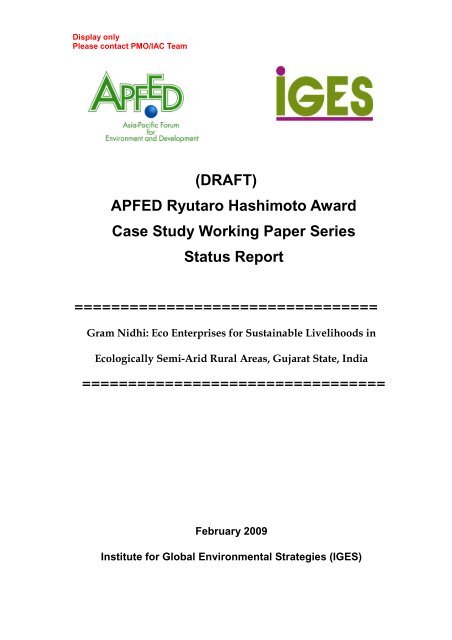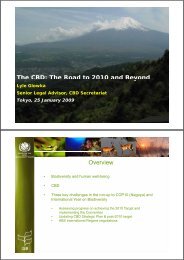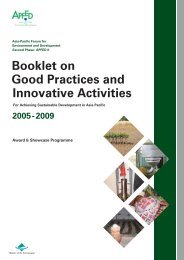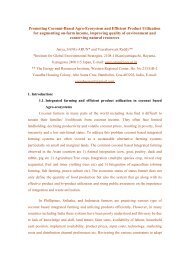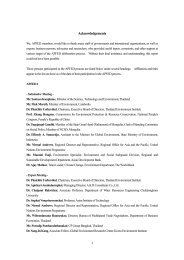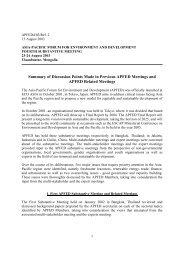Case Study Status Report on Gram Nidhi - APFED
Case Study Status Report on Gram Nidhi - APFED
Case Study Status Report on Gram Nidhi - APFED
Create successful ePaper yourself
Turn your PDF publications into a flip-book with our unique Google optimized e-Paper software.
Display <strong>on</strong>ly<br />
Please c<strong>on</strong>tact PMO/IAC Team<br />
Display <strong>on</strong>ly<br />
Please c<strong>on</strong>tact Display CDE <strong>on</strong>ly staff<br />
for further Please informati<strong>on</strong> c<strong>on</strong>tact CDE staff<br />
for further informati<strong>on</strong><br />
(DRAFT)<br />
<strong>APFED</strong> Ryutaro Hashimoto Award<br />
<str<strong>on</strong>g>Case</str<strong>on</strong>g> <str<strong>on</strong>g>Study</str<strong>on</strong>g> Working Paper Series<br />
<str<strong>on</strong>g>Status</str<strong>on</strong>g> <str<strong>on</strong>g>Report</str<strong>on</strong>g><br />
=================================<br />
<strong>Gram</strong> <strong>Nidhi</strong>: Eco Enterprises for Sustainable Livelihoods in<br />
Ecologically Semi-Arid Rural Areas, Gujarat State, India<br />
=================================<br />
February 2009<br />
Institute for Global Envir<strong>on</strong>mental Strategies (IGES)
<strong>Gram</strong> <strong>Nidhi</strong>: Eco Enterprises for Sustainable Livelihoods in<br />
Ecologically Semi-Arid Rural Areas, Gujarat State, India<br />
<str<strong>on</strong>g>Status</str<strong>on</strong>g> <str<strong>on</strong>g>Report</str<strong>on</strong>g><br />
Kyoko Matsumoto<br />
Project Management Office<br />
This report summarises the findings from <strong>APFED</strong> Hashimoto Ryutaro Silver Award project in 2007,<br />
entitled “<strong>Gram</strong> <strong>Nidhi</strong>: Eco Enterprises for Sustainable Livelihoods in Ecologically Fragile Semi-Arid<br />
Rural Areas, Gujarat State, India”. This project has been implemented by the Centre for<br />
Envir<strong>on</strong>ment Educati<strong>on</strong> (CEE), which has been involved in activities for sustainable development<br />
for over 17 years in ecologically fragile semi-arid rural areas in India. The target villages of this<br />
project are located near Rajikot, Gujarat State in Western India. The missi<strong>on</strong> to the project sites was<br />
c<strong>on</strong>ducted from 5 - 7 February 2009 with a local collaborator, Dr. Madhumita Mishra from TERI<br />
University, India. This preliminary report of the case study has been prepared based <strong>on</strong> summaries<br />
of findings, including some discussi<strong>on</strong>s made with stakeholders and the collaborator.<br />
Background<br />
The efforts for pro-poor in rural areas of India have been made by the Indian government,<br />
internati<strong>on</strong>al organisati<strong>on</strong>s, and other d<strong>on</strong>or agencies. Although tremendous efforts were made,<br />
there were still over 220 milli<strong>on</strong> people in the rural areas living under the poverty line in 2004-2005<br />
(Government of India, 2007). Recently, the ec<strong>on</strong>omic growth of India has been prominent but<br />
despite outstanding ec<strong>on</strong>omic progress, a quarter of nati<strong>on</strong>’s populati<strong>on</strong> earns under the poverty<br />
threshold, which is 356.3 INR. per capita/m<strong>on</strong>th (= approximately USD7.1 in Feb. 2009)<br />
(Government of India, 2007). According to the CEE staff, when measuring poverty in India, it can be<br />
said that if <strong>on</strong>e household with an average of five family members have two calves, the life of<br />
household would be barely over the poverty line in India. Unfortunately, most villagers still could not<br />
meet this baseline. Hence, the practical measures require assisting the rural development.<br />
The <strong>Gram</strong> <strong>Nidhi</strong> project has been implemented in a large area of Gujarat State in Western India,<br />
aiming to establish eco-enterprises for supporting rural development. The initial target villages for<br />
the implementati<strong>on</strong> programme are in semi-arid rural areas with very limited natural resources and<br />
an envir<strong>on</strong>mentally vulnerable area, the Hingolgadh sanctuary (15 km 2 ). The surrounding villagers<br />
depend <strong>on</strong> the natural resource in the area for their livelihood, so that there is c<strong>on</strong>cern about further<br />
degradati<strong>on</strong> of the sanctuary. In additi<strong>on</strong>, the area has been traditi<strong>on</strong>ally cultivated for cott<strong>on</strong>, which<br />
is a water intensive cash crop and there has been soil degradati<strong>on</strong> due to the use of chemical<br />
fertilizers and pesticides. Therefore, the protecti<strong>on</strong> of natural resources in Hingolgadh sanctuary is<br />
required to ensure sustainable development in neighbouring villages. Five villages surrounding the<br />
sanctuary in Jasdan Block have been selected for this project. The key objectives of the project are<br />
follows;<br />
- to establish eco-enterprise through the village-level instituti<strong>on</strong> Paryavaran Vikas<br />
Mandlas(PVM),<br />
- to enhance capacity of target villagers for effective management of natural resources through<br />
the <strong>Gram</strong> <strong>Nidhi</strong> model.<br />
1
Instituti<strong>on</strong>al Setting<br />
The actors of this programme are a leading implementati<strong>on</strong> organisati<strong>on</strong>, the Centre for<br />
Envir<strong>on</strong>ment Educati<strong>on</strong> (CEE), the instituti<strong>on</strong> at village level, Paryavaran Vikas Mandals (PVMs)<br />
and target villages. The Centre for Envir<strong>on</strong>ment Educati<strong>on</strong> was established in 1984, supported by<br />
the Ministry of Envir<strong>on</strong>ment and Forests of the Indian government. The centre aims to improve<br />
public awareness and understanding of the envir<strong>on</strong>ment through developing educati<strong>on</strong> material and<br />
programmes, as well as to create overall envir<strong>on</strong>ment and development strategy for India, pursuing<br />
a better envir<strong>on</strong>ment and a better quality of life. With this background of the establishment of the<br />
CEE, the str<strong>on</strong>g and deep involvements of CEE staff in the target- village c<strong>on</strong>tribute to the success<br />
the implementati<strong>on</strong> of the programme.<br />
The instituti<strong>on</strong>al setting is a primary factor for the substantial success of the project. Before starting<br />
the <strong>Gram</strong> <strong>Nidhi</strong>, CEE has been working since 1988 in the fields for eco-development programmes,<br />
and started assisting in the formati<strong>on</strong> of the Self Help Groups (SHGs) in 1996. Since then, there<br />
have been many programmes implemented in the village and Self Help Group have been set up<br />
already in the villages. The SHGs are formal groups established by the community people, usually<br />
c<strong>on</strong>sisting of 15-20 pers<strong>on</strong>s. The purpose of the formati<strong>on</strong> of SHGs is that even poor people need<br />
access to social and ec<strong>on</strong>omic interacti<strong>on</strong> when they face an emergency situati<strong>on</strong>. With this<br />
background for the formati<strong>on</strong> of SHGS and envir<strong>on</strong>ment, <strong>Gram</strong> <strong>Nidhi</strong> project has been<br />
implemented.<br />
The mechanism of the <strong>Gram</strong> <strong>Nidhi</strong> project shows in Figure 1. The major stakeholders of this project<br />
are Paryavaran Vikas Mandal (PVMs) and NARMADA Trust and entrepreneurs. First, the CEE<br />
formed the PVMs as an informal group, c<strong>on</strong>sisting of mainly youth. The PVM, a legal instituti<strong>on</strong> at<br />
the village level under Bombay Trust Act (1950), is translated as Natural Resources Management<br />
Development Group, c<strong>on</strong>sisting of women and young people to commit to the programme. The CEE<br />
facilitates these PVMs to foster youths and women to participate in the initiative for envir<strong>on</strong>mentally<br />
- friendly activities. The 450 members of PVMS for the Hingolgadh Nature Educati<strong>on</strong> Sanctuary in<br />
Rajikot district are currently engaging in instituti<strong>on</strong>al activities (CEE, 2008). The willingness for<br />
voluntary works for envir<strong>on</strong>ment and development at the village is a criteri<strong>on</strong> for becoming the<br />
member of PVMs.<br />
The CEE set up the Eco-Enterprise Investment committee (EIC) which c<strong>on</strong>sists of the<br />
representative of PVMs, NARMADA TRUST, CEE, local government officials, financial instituti<strong>on</strong>s,<br />
NGOs and experts. Eco Enterprise Investment Committee (EIC) will c<strong>on</strong>duct the screening based<br />
<strong>on</strong> the criteria.<br />
The <strong>Gram</strong> <strong>Nidhi</strong> project supports access to reas<strong>on</strong>able credit and low interest. The villagers first<br />
have to become a member of SHGs to receive the benefits of the borrowing and credit. The<br />
villagers apply for the credits to SHGs, the applicati<strong>on</strong> is forwarded the NARMAD Trust, and the EIC<br />
makes a final decisi<strong>on</strong> for an approval. Currently, the villagers can borrow m<strong>on</strong>ey with 7 % interest,<br />
which is a relatively low rate compared to other similar microfinance schemes. For example, the<br />
basic interest at <strong>Gram</strong>een Bank, Bangladesh is 10 % with flat rate, and the housing loan is 8%.<br />
Although the SHGs repaid to the NARMADA TRUST actually with 5 % interest, the SHGS repaid<br />
7%, and 2% of interest as a safety fund. The guideline was set up for lending funds to villagers by<br />
NARMADA Trust members, NGOs, and CEE.<br />
2
Flows for the implementati<strong>on</strong> of <strong>Gram</strong> <strong>Nidhi</strong><br />
1 Approval by Eo-Enterprise Investment Committee (EIC)<br />
2 NARMADA Trust disburses funds to PVMs<br />
NARMADA Trust<br />
Revolving fund :5% interest<br />
Paryavaran Vikas Mandals (PVMS)<br />
Revolving fund :no interest<br />
Revolving fund :7% interest<br />
Eco Enterprise Fund (EEF)<br />
Eco-entrepreneurs<br />
Members of Eco-Enterprise Investment Committee (EIC)<br />
NARMADA Trust<br />
Paryavaran Vikas Mandals (PVMS)<br />
CEE (Center for Envir<strong>on</strong>ment Educati<strong>on</strong>)<br />
NGOs<br />
Financial Instituti<strong>on</strong>s<br />
Local Government Officials<br />
Figure 1: Flow of the Implementati<strong>on</strong> of <strong>Gram</strong> <strong>Nidhi</strong> Project<br />
The applicati<strong>on</strong> should be envir<strong>on</strong>mentally sound, therefore there are many criteria<br />
including the points for assisting envir<strong>on</strong>mentally sustainable activities as well as for improvement<br />
of their lives. These eligibility criteria were prepared by EIC for enterprise financing;<br />
• Projects should be envir<strong>on</strong>mentally sound, ec<strong>on</strong>omically viable and technically<br />
feasible. Dem<strong>on</strong>strate an impact <strong>on</strong> envir<strong>on</strong>mental c<strong>on</strong>servati<strong>on</strong> efforts at the project<br />
site and provide financial benefits to the community and local envir<strong>on</strong>mental<br />
organizati<strong>on</strong>s, c<strong>on</strong>tributing to local employment;<br />
• In the proposed enterprises low cost envir<strong>on</strong>mentally friendly practices and<br />
opti<strong>on</strong>s should be adopted c<strong>on</strong>tributing to the strengthening of biodiversity and<br />
sustainable development. Compulsorily at least three of the following<br />
practices/technology should be applied: bio-pesticides, vermi-compost/bio-compost,<br />
vermin-wash, bio-c<strong>on</strong>trol by yellow strip, cow urine, and saplings;<br />
• To ensure viability smaller operati<strong>on</strong>al units were c<strong>on</strong>sidered. The average project<br />
cost for <strong>on</strong>-farm development activities will be restricted to Rs.20.000/-per enterprise<br />
for individual eco-entrepreneurs; and<br />
• The successful enterprise has possibilities of large scale replicable in the other<br />
nearby rural area.<br />
Up to now, the payback of all loans is 100 percent, and 7 SHGs are currently gaining benefits from<br />
<strong>Gram</strong> <strong>Nidhi</strong> funds.<br />
3
Photo 1& 2: Members of NARMADA TRUST<br />
Activities supported by <strong>Gram</strong> <strong>Nidhi</strong><br />
Many activities supported by <strong>Gram</strong> <strong>Nidhi</strong> have been funded since 2004. From 2004-2008, organic<br />
agriculture farming and animal husbandry are the main funding activities, and over 250 cases have<br />
been funded (pers<strong>on</strong>al c<strong>on</strong>tact with CEE). In the target village, PVMs groups are now producing<br />
valuable organic crops, as well as traditi<strong>on</strong>al medicine plants for market. Also, the activity for animal<br />
husbandry which provides training and advice to the villagers in order to increase milk producti<strong>on</strong>,<br />
such as selecti<strong>on</strong> of calves, which resulted in increased income generati<strong>on</strong>. The milk collecti<strong>on</strong><br />
associati<strong>on</strong> was formed and a milk collecti<strong>on</strong> house in the village was run by the villagers<br />
themselves. Before the introducti<strong>on</strong> of <strong>Gram</strong> <strong>Nidhi</strong> project, the villagers hasd <strong>on</strong>ly produced milk for<br />
their own c<strong>on</strong>sumpti<strong>on</strong>, but now many villagers can produce more milk for sale. In additi<strong>on</strong>, the<br />
delivery of milk means that there is now easy and direct access to the market, following the<br />
establishment of a milk collecti<strong>on</strong> house in the village. The villagers bring milk twice a day to the<br />
milk collecti<strong>on</strong> house, and a member of the milk collecti<strong>on</strong> associati<strong>on</strong> measures and records its<br />
quality and quantity. Based <strong>on</strong> the record, the villagers get payment. The products by <strong>Gram</strong> <strong>Nidhi</strong><br />
such as oil butter are now widely recognised for their quality, both inside and outside of India. Some<br />
members directly negotiate with buyers from Australia and send products to them. Also, ecofriendly<br />
activities are supported by <strong>Gram</strong> Nidi, such as making compost, rainwater-harvesting<br />
structures, the c<strong>on</strong>structi<strong>on</strong> of toilet facilities and drainage system inside the village.<br />
Photo 3,4,5,6 From left to right: ;Products by <strong>Gram</strong> <strong>Nidhi</strong> Entrepreneurs, the house for milk collecti<strong>on</strong>, cactus fruit for juice, rainwater<br />
harvesting structure <strong>on</strong> the roof top<br />
4
Positive impact to local community<br />
The percepti<strong>on</strong> of the villagers both male and female has been dramatically changing after the<br />
implementati<strong>on</strong> of the project. The traditi<strong>on</strong>al Indian society, a male dominant society where there<br />
are no women participating in public settings, still str<strong>on</strong>gly prevails in the rural area. In the early<br />
stage of <strong>Gram</strong> <strong>Nidhi</strong> project, the men and old women were very sceptical of the project, citing a<br />
negative effect <strong>on</strong> their wives and the other women. Now, however, they are pleased to send them<br />
to SHGs meetings.<br />
The villagers also have recognised that organic farming generates more income due to low input<br />
costs and good market value in a sustainable manner. The villagers are now able to save some<br />
m<strong>on</strong>ey for further investment in livestock. The savings also can generate further investment for the<br />
improvement of their lives, such as access to drinking water, toilets, and c<strong>on</strong>structi<strong>on</strong> of a drainage<br />
system in the village. The improvement of their lives in terms of sanitati<strong>on</strong> and health can be<br />
physically observed. For example, some houses have been equipped with the rainwater- harvesting<br />
structure <strong>on</strong> the roof, and water storage underground through the <strong>Gram</strong> <strong>Nidhi</strong> loan. Also, the<br />
awareness of sanitati<strong>on</strong> and health has increased. After the implementati<strong>on</strong> of the project, the<br />
villagers are more aware of their sanitati<strong>on</strong> and health, and some toilets have been installed.<br />
Also, increased additi<strong>on</strong>al income and saving has been invested in their children’s educati<strong>on</strong>, health,<br />
sanitati<strong>on</strong> facility, and safe drinking water. In the target village, many members think that educati<strong>on</strong><br />
is important for developing their capacity as entrepreneurs. One female entrepreneur stated that<br />
they want to give priority to girls for educati<strong>on</strong> over boys, since girls have more potential to be good<br />
entrepreneurs, and through the enterprise activities, they can have more opportunity to explore<br />
outside of the village, as well as to improve their lives.<br />
It also notes that after implementing the programme, the rural ec<strong>on</strong>omy has been diversified, so that<br />
now it is less vulnerable to natural disasters and other inevitable stresses.<br />
Now the villagers have developed c<strong>on</strong>fidence to run the self-employment style enterprise to<br />
improve their life.<br />
Key for success<br />
It is important to note that CEE has been involved in the target area for a l<strong>on</strong>g time. Without this<br />
l<strong>on</strong>g-term involvement of CEE, the project may not have built up such a big success. Before starting<br />
the <strong>Gram</strong> <strong>Nidhi</strong>, CEE has been working in the target area since 1988 for Eco-development<br />
programmes and from 1996 <strong>on</strong>ward, the formati<strong>on</strong> of Self Help Group (SHGs) was started. Since<br />
then, many programmes have been implemented in the village and women's SHGs have already<br />
existed in the villages. On this foundati<strong>on</strong> and envir<strong>on</strong>ment, the <strong>Gram</strong> <strong>Nidhi</strong> has started.<br />
Photo 7: Women Entrepreneurs<br />
5
The innovativeness for this micro finance scheme is not <strong>on</strong>ly to carry out pro-poor measures, but<br />
also to combine the programme with envir<strong>on</strong>mental educati<strong>on</strong> for promoting their sustainable living.<br />
The <strong>Gram</strong> <strong>Nidhi</strong> model is based <strong>on</strong> three E’s: Ec<strong>on</strong>omic Support, Extensi<strong>on</strong> service, and<br />
Envir<strong>on</strong>mental awareness. The package of measures based <strong>on</strong> three E’s c<strong>on</strong>ferred a benefit <strong>on</strong><br />
entrepreneurs. To take an example of many, the Technical Assistance Fund (TAF) is introduced into<br />
the model. The villagers in the rural area have not been able to access micro-credit due to lack of<br />
knowledge, as well as not understanding why it is important to c<strong>on</strong>duct sustainable practices such<br />
as organic farming rather than producing an instant cash crops like cott<strong>on</strong>. Therefore, the CEE<br />
formed the TAF to provide a necessary training and the technical assistance for improving their<br />
agricultural and livelihood in a sustainable manner. The TAF plays a role as an advisory service for<br />
c<strong>on</strong>sulting about financial c<strong>on</strong>trol, accounting, as well as offering technical assistance for agriculture,<br />
animal husbandry, agro-forestry, horticulture, agro-processing and water c<strong>on</strong>servati<strong>on</strong>. Through<br />
these activities, the TAF significantly c<strong>on</strong>tributes to c<strong>on</strong>vince villagers of the benefits of practicing<br />
sustainable farming in the l<strong>on</strong>g term.<br />
In additi<strong>on</strong>, the <strong>Gram</strong> <strong>Nidhi</strong> model applies an eco-package c<strong>on</strong>cept providing further positive<br />
impacts <strong>on</strong> promoting envir<strong>on</strong>mental-friendly entrepreneurs. The eco-package provides the utmost<br />
benefits for each entrepreneur with linkage to the market at the village level. The <strong>Gram</strong> <strong>Nidhi</strong><br />
diversifies the activities of entrepreneurs for funds, so that even a landless farmer is able to start an<br />
enterprise such as processing activities for milk producti<strong>on</strong>. A chain of suppliers and c<strong>on</strong>sumers at<br />
the local level also strengthens community development.<br />
Another essential factor is the presence of a female staff member at the local office of CEE. She<br />
has been heavily engaged in communicati<strong>on</strong> with women’s groups at the village level from the initial<br />
stage. The aim is to organise women’s group as SHG to discuss family issues, children educati<strong>on</strong>,<br />
health, sanitati<strong>on</strong>, therefore the presence of a woman as part of the staff is essential for villagers to<br />
facilitate the discussi<strong>on</strong>, as well as to give advise <strong>on</strong> these issues. Now all villagers, even the men,<br />
are building trusting relati<strong>on</strong>ships with the woman staff member, and when she visits the village, the<br />
men are willing to send their wives to the women’s group, as well as encouraging their wives to<br />
get involved in various outside activities, such as participati<strong>on</strong> of the agricultural fair outside of the<br />
village. Also, she is a model to which many village girls can aspire.<br />
Figure 2: <strong>Gram</strong> <strong>Nidhi</strong> programme linkage to the market<br />
6
Future Plan and Challenge<br />
This micro finance scheme differs from others which primarily focus <strong>on</strong> pro-poor activities. The<br />
<strong>Gram</strong> <strong>Nidhi</strong> model is a combinati<strong>on</strong> of micro credit and support in building envir<strong>on</strong>mentally<br />
sustainable and ec<strong>on</strong>omically variable enterprises to improve the target villagers’ lives. The <strong>Gram</strong><br />
<strong>Nidhi</strong> model also proved that the timely access to a small amount of funds can make a change the<br />
rural development. In additi<strong>on</strong>, the l<strong>on</strong>g-term involvement of NGOs in the target area is an essential<br />
factor to c<strong>on</strong>duce a successful practice. The <strong>Gram</strong> <strong>Nidhi</strong> Project shows that the availability of funds<br />
in the early stage, the presence of NGOs, and l<strong>on</strong>g-term involvement in the target area are essential<br />
to implement the project.<br />
The villagers are now thinking of raising more funds to expand their entrepreneurial skills to other<br />
activities. Although the villagers have been saving m<strong>on</strong>ey to increase the fund m<strong>on</strong>ey, it is not so<br />
easy for villagers to save extra m<strong>on</strong>ey regularly. The neighbouring villagers also want to start the<br />
similar micro finance scheme, but they have not currently started the programme yet due to the lack<br />
of basic funds. C<strong>on</strong>versely, the <strong>Gram</strong> <strong>Nidhi</strong> was sp<strong>on</strong>sored by the World Bank, and this c<strong>on</strong>diti<strong>on</strong><br />
actually allows the CEE to start the programme.<br />
Without the interventi<strong>on</strong> of a funding organisati<strong>on</strong>, is it possible for the villagers to replicate a similar<br />
micro finance scheme by themselves? After c<strong>on</strong>ducting the case study, it seems that the absence of<br />
a funding organisati<strong>on</strong> is a limiting factor to implement the programme. However, to sustain and<br />
expand the <strong>Gram</strong> Nidihi Project, the CEE still needs to take an initiative to seek other funding<br />
organisati<strong>on</strong>s to expand the project. In additi<strong>on</strong>, CEE itself must bear some of the cost of basic<br />
expenditure such as pers<strong>on</strong>nel for the c<strong>on</strong>sultati<strong>on</strong> for sustaining the project. In this regards, the<br />
CEE is currently working to expand the <strong>Gram</strong> <strong>Nidhi</strong> model in collaborati<strong>on</strong> with Yale School of<br />
Management. Further study of existing mechanisms of <strong>Gram</strong> <strong>Nidhi</strong> require the identificati<strong>on</strong> of<br />
significant factors for replicati<strong>on</strong>, as well as the role of NGOs and government for further<br />
improvement of rural development.<br />
References<br />
Centre for Envir<strong>on</strong>ment Educati<strong>on</strong> (CEE).<br />
http://www.ceeindia.org/cee/index.html<br />
Centre for Envir<strong>on</strong>ment Educati<strong>on</strong> (CEE) 2008. Annual <str<strong>on</strong>g>Report</str<strong>on</strong>g>.<br />
Government of India. 2007. Poverty Estimates for 2004-2005.<br />
http://planningcommissi<strong>on</strong>.nic.in/news/prmar07.pdf<br />
<strong>Gram</strong>een Bank Home page<br />
http://www.grameen-info.org/index.php?opti<strong>on</strong>=com_fr<strong>on</strong>tpage&Itemid=68<br />
<strong>Gram</strong>een Bank, Credit Delivery System<br />
http://www.grameen-info.org/index.php?opti<strong>on</strong>=com_c<strong>on</strong>tent&task=view&id=24&Itemid=127<br />
7
For further inquiries, please c<strong>on</strong>tact:<br />
<strong>APFED</strong> Secretariat<br />
c/o Institute for Global Envir<strong>on</strong>mental Strategies (IGES)<br />
2108-11 Kamiyamaguchi, Hayama, Kanagawa, 240-0115, Japan<br />
E-mail: apfed@iges.or.jp<br />
URL: http://www.apfed.net/<br />
IGES coordinates and supports <strong>APFED</strong> activities as the <strong>APFED</strong> Secretariat in<br />
collaborati<strong>on</strong> with <strong>APFED</strong> members and policy research institutes for<br />
envir<strong>on</strong>mental management and sustainable development in the Asia-Pacific<br />
regi<strong>on</strong>.<br />
Institute for Global Envir<strong>on</strong>mental Strategies (IGES)<br />
2108-11 Kamiyamaguchi, Hayama, Kanagawa, 240-0115, Japan<br />
Tel: +81-(0)46-855-3700 Fax: +81-(0)46-855-3709<br />
E-mail: iges@iges.or.jp<br />
URL: http://www.iges.or.jp/


